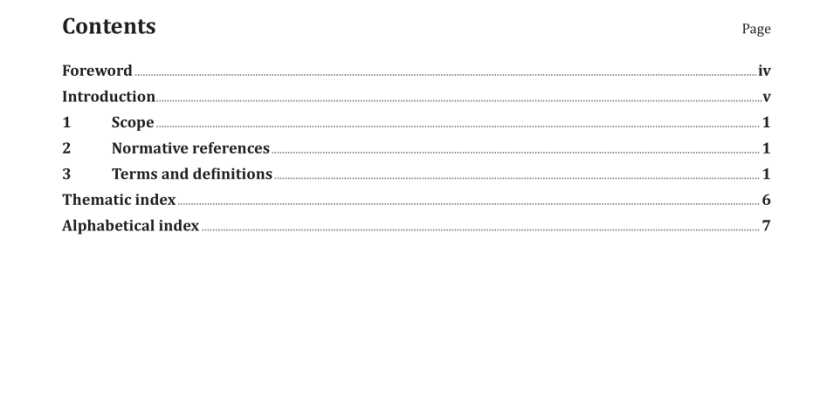ISO 9235:2021 pdf download – Aromatic natural raw materials — Vocabulary.
3.6 concentrated essential oil folded oil essential oil (3.11) treated by a physical process in order to concentrate one or more components considered to be of interest 3.7 concrete extract (3.13) obtained from a fresh natural raw material (3.20) by extraction with one or several solvents Note 1 to entry: The solvent or solvents are then totally or partly removed. 3.8 distillate product of condensation obtained after distillation of a natural raw material (3.20) 3.9 dry-distilled essential oil essential oil (3.11) obtained by distillation of wood, barks, roots or gums, without addition of water or steam EXAMPLE Birch tar essential oil. 3.10 essential oil of fruit juice essential oil (3.11) obtained from a fruit juice during its concentration or during UHT (flash pasteurization) treatment Note 1 to entry: The water and aromatic oils are separated to yield an aromatic oil phase and a dilute water phase, which contains the water-soluble aromatic components. 3.11 essential oil product obtained from a natural raw material (3.20) of plant origin, by steam distillation, by mechanical processes from the epicarp of citrus fruits or by dry distillation, after separation of the aqueous phase – if any – by physical processes Note 1 to entry: The essential oil can undergo physical treatments which do not result in any significant change in its composition (e.g. filtration, decantation, centrifugation). Note 2 to entry: The phrase “Essential oil of …” has been used instead of “Oil of …” in all ISO/TC 54 standards published since 2010. 3.12 essential oil obtained by steam distillation essential oil (3.11) which is obtained by steam distillation with addition of water to the still (hydrodistillation) or without addition of water to the still (directly by steam) EXAMPLE Essential oil of orris (commonly named “iris butter”).
3.23 pomade perfumed fat obtained from a flower, either by “cold enfleurage” (diffusion in particular of the odoriferous compounds of the flower in the fat) or by “hot enfleurage” (digestion or immersion of the flower in the melted fat) 3.24 post-treated essential oil product having undergone a post-treatment Note 1 to entry: This type of product is designated as “essential oil preceded by the adjective specifying the type of treatment” e.g. decolourized essential oil, washed essential oil, iron eliminated essential oil. 3.25 rectified? essential? oil essential oil (3.11) which has been subjected to a fractional distillation in order to modify the content of certain compounds, its colour or both EXAMPLE Rectified mint essential oil. 3.26 resin product obtained from oleoresin (3.18), by as complete as possible elimination of the volatile compounds 3.27 resinoid extract (3.13) obtained from a dry plant natural raw material by extraction with one or several solvents EXAMPLE Incense, benzoin, elemi. Note 1 to entry: The solvent or solvents are then totally or partly removed. 3.28 supercritical? fluid? extract extract (3.13) obtained by treating a natural raw material (3.20) in a supercritical fluid followed by a separation by expansion EXAMPLE Coffee CO 2 extract, pink peppercorns CO 2 extract. Note 1 to entry: The extract so obtained may undergo physical treatments which do not result in any significant changes in its composition (e.g. filtration, decantation, centrifugation).
3.29 “terpeneless and sesquiterpeneless” essential oil rectified essential oil (3.25) from which certain fractions containing mainly the mono- and sesquiterpene hydrocarbons have been partly eliminated 3.30 “terpeneless” essential oil rectified essential oil (3.25) from which certain fractions containing mainly the monoterpene hydrocarbons have been partly eliminated 3.31 terpenes products mainly consisting of terpenic hydrocarbons obtained as by-products of an essential oil (3.11) by distillation, concentration or other separation techniques EXAMPLE Orange terpenes, mint terpenes.
3.32 tincture and infusion solution obtained by maceration of a natural raw material (3.20) in ethanol at variable concentrations or in water EXAMPLE Tincture of benzoin, tincture of grey amber, vanilla infusion. 3.33 volatile concentrate concentrated water-soluble volatile substances recovered from the evaporated water of a fruit juice, a vegetable juice or an aqueous plant infusion EXAMPLE Orange juice volatile concentrate, liquorice volatile concentrate, coffee volatile concentrate. 3.34 “x-free” essential oil essential oil (3.11) from which a component “x” has been partly or completely eliminated EXAMPLE Furocoumarin-free essential oil of bergamot, essential oil of Mentha arvensis with partially reduced menthol content.
